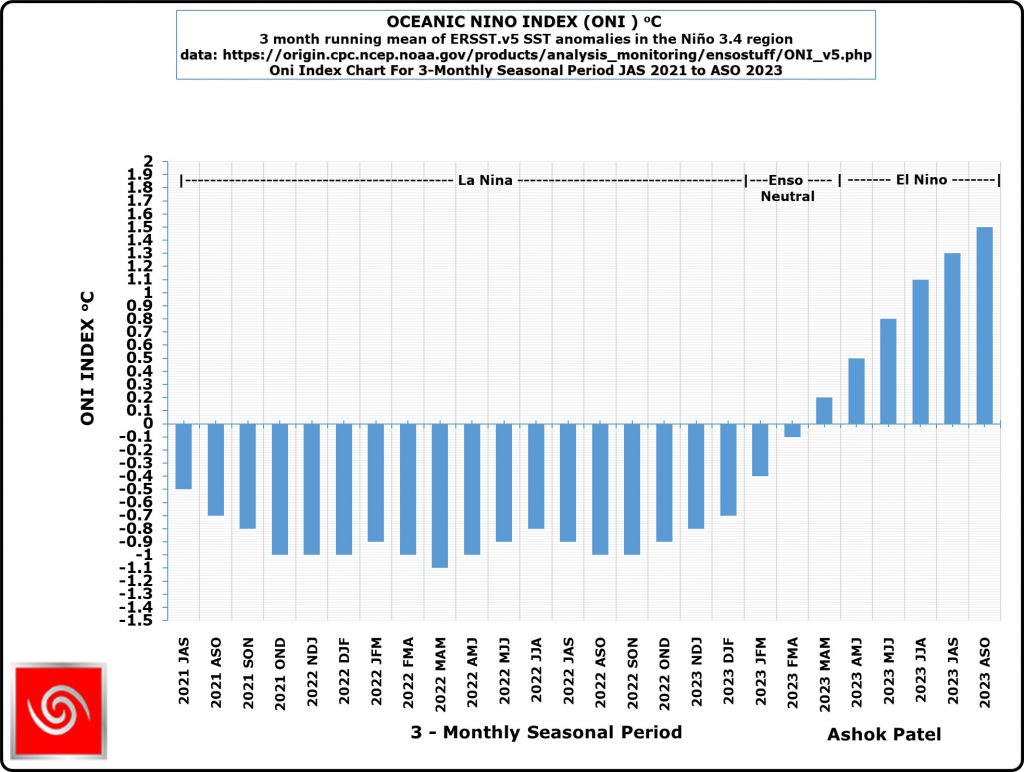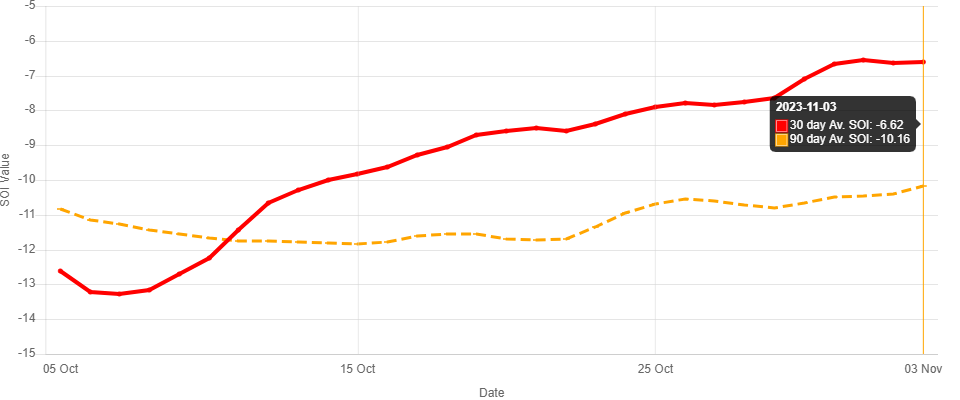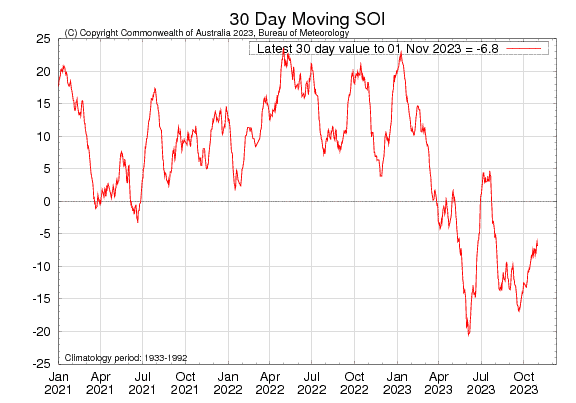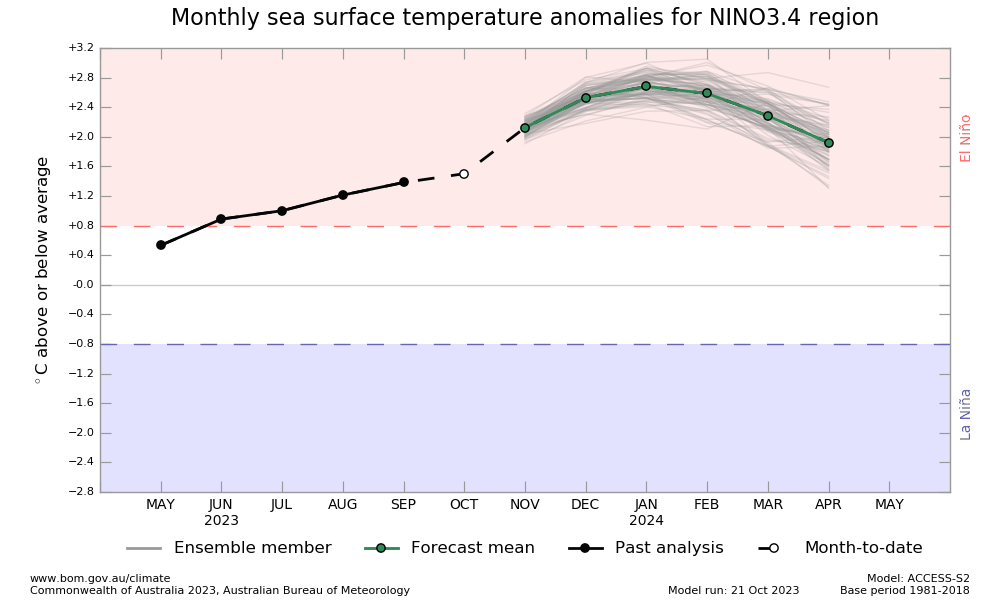Full Fledged El Nino Established End Of October 2023 – A Month After The Completion Of Southwest Monsoon In India
Enso Status on 4th November 2023
The first four El Nino thresh holds being AMJ 2023 ONI at +0.5ºC, MJJ 2023 ONI at +0.8ºC, JJA 2023 ONI at +1.1ºC and JAS 2023 ONI at +1.3ºC. Now the Fifth El Nino thresh hold has been achieved with ASO 2023 ONI at +1.5ºC, thereby completing five consecutive ONI >= +0.5ºC, fulfilling the criteria for a Full Fledged El Nino.
Ashok Patel’s Analysis & Commentary :
It had been mentioned here during the start of Southwest Monsoon in India that the earliest a Full Fledged El Nino can be established would be at the end of October 2023. With the fifth El Nino thresh hold of ASO 2023 at +1.5ºC a Full Fledged El Nino has been established a month after the completion of Indian Southwest Monsoon season which ended at the end of September 2023. The other development is that SOI that was -13.0 level is currently -7.0 level end of October.
Indian Monsoon & Enso relationship for India:
Based on earlier more than 100 years weather Data for Indian Summer Monsoon, The Average Rainfall in an El Nino years is 94% of LPA while in La Nina Years it has been 106 % of LPA for the whole country. Monsoon Rainfall over India had been +94.4% of LPA at the end of 30th September 2023. El Nino or La Nina may affect the Monsoon differently for different Regions of India and warrants research for concrete co-relations for each region of India if any. Performance of Southwest Monsoon 2023 over the entire Country was much better than expected.
How ONI is determined:
The ONI is based on SST departures from average in the Niño 3.4 region, and is a principal measure for monitoring, assessing, and predicting ENSO. Defined as the three-month running-mean SST departures in the Niño 3.4 region. Departures are based on a set of further improved homogeneous historical SST analyses (Extended Reconstructed SST – ERSST.v5).
NOAA Operational Definitions for El Niño and La Niña, El Niño: characterized by a positive ONI greater than or equal to +0.5ºC. La Niña: characterized by a negative ONI less than or equal to -0.5ºC. By historical standards, to be classified as a full-fledged El Niño or La Niña episode, these thresholds must be exceeded for a period of at least 5 consecutive overlapping 3-month seasons.
CPC considers El Niño or La Niña conditions to occur when the monthly Niño3.4 OISST departures meet or exceed +/- 0.5ºC along with consistent atmospheric features. These anomalies must also be forecast to persist for 3 consecutive months.
The Climate Prediction Center (CPC) is a United States Federal Agency that is one of the NECP, which are a part of the NOAA
Latest Oceanic Nino Index Graph Shows
El Nino Has Been Established End Of October 2023
The Table below shows the monthly SST of Nino3.4 Region and the Climate adjusted normal SST and SST anomaly from July 2021. Climate Base 1991-2020. ERSST.v5
Period Nino3.4 ClimAdjust YR MON Temp.ºC Temp.ºC ANOM ºC 2021 7 26.90 27.29 -0.39 2021 8 26.32 26.86 -0.53 2021 9 26.16 26.72 -0.55 2021 10 25.78 26.72 -0.94 2021 11 25.76 26.70 -0.94 2021 12 25.54 26.60 -1.06 2022 1 25.61 26.55 -0.95 2022 2 25.88 26.76 -0.89 2022 3 26.33 27.29 -0.97 2022 4 26.72 27.83 -1.11 2022 5 26.83 27.94 -1.11 2022 6 26.98 27.73 -0.75 2022 7 26.60 27.29 -0.70 2022 8 25.88 26.86 -0.97 2022 9 25.65 26.72 -1.07 2022 10 25.73 26.72 -0.99 2022 11 25.80 26.70 -0.90 2022 12 25.75 26.60 -0.86 2023 1 25.84 26.55 -0.71 2023 2 26.30 26.76 -0.46 2023 3 27.19 27.29 -0.11 2023 4 27.96 27.83 0.14 2023 5 28.40 27.94 0.46 2023 6 28.57 27.73 0.84 2023 7 28.31 27.29 1.02 2023 8 28.21 26.86 1.35 2023 9 28.32 26.72 1.60 2023 10 28.38 26.72 1.66
Indications and analysis of various International Weather/Climate agencies monitoring ENSO conditions is depicted hereunder:
Summary by: Climate Prediction Center / NCEP Dated 30th October 2023
ENSO Alert System Status: El Niño Advisory
El Niño conditions are observed.*
Equatorial sea surface temperatures (SSTs) are above average across the central and eastern Pacific Ocean.
The tropical Pacific atmospheric anomalies are consistent with El Niño.
El Niño is anticipated to continue through the Northern Hemisphere spring
(with an 80% chance during March-May 2024).* *
Note: These statements are updated once a month (2nd Thursday of each month) in association with the ENSO Diagnostics Discussion, which can be found by clicking here.
Recent (preliminary) Southern Oscillation Index values as per The Long Paddock – Queensland Government.
30 Days average SOI was -6.63 at the end of October 2023 and was -6.62 on 3rd November 2023 as per The Long Paddock – Queensland Government and 90 Days average SOI was -10.16 on 3rd November 2023. During the last month the SOI has moved from -13.00 during the first week of October to -6.63 level currently.
Southern Oscillation Index
As per BOM, Australia
The 30-day Southern Oscillation Index (SOI) for the period ending 31 October 2023 was −6.8, which was -13.0 around the first week of October.
Sustained negative values of the SOI below −7 typically indicate El Niño while sustained positive values above +7 typically indicate La Niña. Values between +7 and −7 generally indicate neutral conditions.
As per BOM – Australia 24 October 2023
El Niño and positive Indian Ocean Dipole persist
An El Niño and a positive IOD are underway.
Oceanic indicators exhibit a clear El Niño state. Central and eastern Pacific sea surface temperatures (SSTs) continue to exceed El Niño thresholds, with warmer than average waters beneath the surface supporting the warmth at the surface. Models indicate some further warming of central to eastern Pacific SSTs is likely, with SSTs remaining above El Niño thresholds into the early southern hemisphere autumn 2024.



